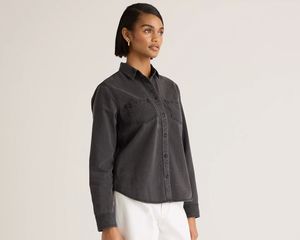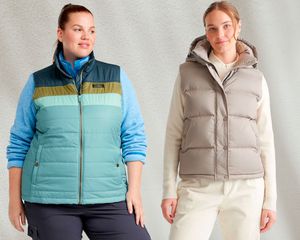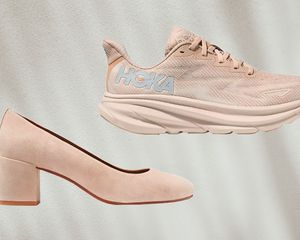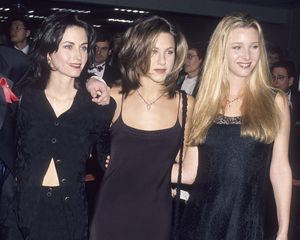When you think of a country club, perfectly manicured lawns, sweaters casually slung over shoulders, and iced teas sweating on a patio table come to mind. And when visualizing who is teeing up on those lawns or wearing those sweaters, so, too, does a particular kind of person: well-manicured, possibly blonde, and definitely white.
Country club style, situated on the sportier end of the greater preppy spectrum, signifies wealth, privilege, and access. Yet despite this, it has always been popular with—and remixed by—people who were historically more likely to be pouring those teas than drinking them.
***
:max_bytes(200000):strip_icc()/GettyImages-2063638288-8cf3befdeedb42b39d85177d5321b71f.jpg)
Christian Vierig/Getty Images
“Preppy gets reincarnated over and over again, and it has kind of a different look each time, but it retains something of ‘moneyed’ and ‘sporty,’” says Avery Trufelman, creator, host, and producer of the podcast Articles of Interest, which covered the topic of preppy fashion extensively in the seven-part series American Ivy. You undoubtedly know the look: Think loafers, button-up shirts, and navy blazers.
The style as we think of it today can generally be traced back to Ivy League students in the 1950s. “It basically started as sports clothes,” says Trufelman. The boys—and at this time, they were all boys—would wear British sports clothes to play tennis, “but then they wouldn’t change when they went to class and they wouldn’t change for dinner.” At a time when going to church or the office would always require a hat and tie, the preppy look was decidedly off the clock. “It was kind of athleisure,” Trufelman observes. “It’s the same mentality behind it.”
Much like at Ivy League institutions, the turn-of-the-century dress code at HBCUs (historically Black colleges and universities) had consisted of more formal attire. This was, in a sense, replicating the class structures of the white community, notes Barnard College Professor Monica L. Miller, Ph.D., author of Slaves to Fashion: Black Dandyism and the Styling of Black Diasporic Identity. So when the sartorial tide shifted at Ivies, those same changes made their way to hollowed historically Black halls. “The college wardrobe becomes something that both Black people and white people are interested in, and the college wardrobe is something that’s khakis, white shirts—that kind of thing—across the board,” says Miller. “But the Black folks do it differently.”
:max_bytes(200000):strip_icc()/GettyImages-1933423350-5342e110695744179c4a2bbbe2323fc8.jpg)
Giovanni Giannoni / WWD via Getty Images
Both Miller and Trufelman cite jazz trumpeter and perennial style icon Miles Davis as a key influence for Black preps. “When you see a Black collegiate person at that time wearing khakis and a white shirt and a blazer, you also see Miles Davis wearing that,” says Miller. “So it’s not just about ‘Can we look like Harvard at Howard?’ It’s also ‘Can we look like Miles Davis?’”
Though preppy fashion receded as the counterculture movement ushered in a shaggier mainstream style in the 1960s and early 1970s, it never really went away, and by the ’80s, it was back in full force. A seminal moment in prep history occurred at the top of the decade, with the publication of Lisa Birnbach’s tongue-in-cheek The Official Preppy Handbook. Birnbaum dedicates a section of the book to the country club, describing it as a place where those with time (and social cachet) connect. And much like the Ivy League schools that its members went to, these clubs have historically been exclusionary: The New York Times published reports on their segregation policies in the 1970s, ’80s, and ’90s.
But as sneaker influencer and Ralph Lauren collector Dallas Penn points out, just because Black people weren’t allowed to join country clubs, it doesn’t mean they weren’t there. “Black people were in the country clubs—we just weren’t members,” he says. “We’re caddying, bussing tables, serving—we’re experiencing the visceral connection [to] how wealth adorns itself, how it presents itself.”
:max_bytes(200000):strip_icc()/GettyImages-112027034-38227ef0f20e41fca12314e361fb53dc.jpg)
KMazur / WireImage / Getty Images
When these servers and caddies adopted these styles for themselves, they made them thoroughly their own through a unique blend of irony and aspiration. “There’s a lot of irony in it, and the irony is part of the joy,” says Miller.
Similar to how the affluent Black preps of the 1950s drew inspiration from celebrities like Miles Davis, Black participants in the more democratized preppy culture of the 1980s and beyond put their unique spin on the look. “It’s about making it extra somehow—color, fabric, accessories,” says Miller, pointing to the oversize silhouettes and accessories such as Timberland boots that became popular with hip-hop artists in the late 20th and early 21st centuries. “Timberlands are work shoes, not dress shoes,” she observes. “It’s saying, ‘I get this, but this is how it works in my context.’”
The marriage of preppy style and streetwear might seem at odds. But in reality, it makes perfect sense: As rappers told stories of building empires in the underground economy, their style reflected “taking on the uniform of capitalism but doing something with it,” says Miller. And for the descendants of enslaved laborers, there’s an added level of critique in adopting the attire of elite leisure over, say, office wear. “A suit is one thing,” observes Penn. “But to have enough bread to be luxurious in a casual space? Now your paper is up.”
:max_bytes(200000):strip_icc()/GettyImages-51270053-bf55d857ec6343c4aee3e4229fdc7b9b.jpg)
Clive Brunskill / Getty Images
From André 3000 in the aughts to Tyler, the Creator, today, Black folks have infused country club dressing with joyful in-group signifiers. Perhaps nowhere has the playfulness and joy of Black dressing more famously challenged—and transformed—a hollowed preppy space than in the career of tennis superstar Serena Williams. In a sport associated with exclusivity and country clubs, Serena and her sister Venus were “already seen as sort of outside the line,” notes Miller. And they embraced standing out. In game-day ’fits like a denim tennis skirt and studded black tank (that wouldn’t have looked out of place in a J.Lo video) or a one-shouldered lilac tutu, Serena wore “things that are functional for her but also fun for her—it becomes about color; it becomes about design,” observes Miller. In the process, Serena transformed leisure attire (not unlike the Ivy Leaguers of the 1950s), trailblazing “not only in terms of what she’s able to do on the court but what she’s able to do with fashion.”
Preppy fashion has managed to not only survive but thrive in the social media era. Similar to how traces of hip-hop can be heard in rock, country, and pop, preppy touches—comfortable loafers, striped sweater vests—are worn by people who would never describe themselves as such and who would never set foot in a country club. Amid all the fleeting aesthetics and trends, a style that’s been around for more than half a century seems timeless, a shortcut to feeling a little more grown-up and put together. Adding a little prep to your step can be a way to tap into something essentially American while staying true to yourself. “American exceptionalism is first and foremost in how we present ourselves,” as Penn says. “Low-key: It’s all about cosplay in America.”
:max_bytes(150000):strip_icc()/serena-williams-byrdie-recirc-2a-e616fe5d667a4437a6bde9c78c5db37e.jpg)
:max_bytes(150000):strip_icc()/serena-williams-byrdie-013-1e0da7555cf84b5b906bd3a2479ab0c7.jpg)
:max_bytes(150000):strip_icc()/Byr_Bside_Recirc-e2d2054a60ca45f2a874d741b4aa452f.jpg)
:max_bytes(150000):strip_icc()/Byr_IndieSleaze_Recirc-fb815afe9bf4434e887a34e29caedb71.jpg)
:max_bytes(150000):strip_icc()/Byr_WYNreview_Recirc-dfb245c8e10c41c7afcf8f40f24741fe.jpg)
:max_bytes(200000):strip_icc()/Byr_POCcountryClubStyle_SF-3b2d9d60031041c98d6af2edaf4ec4c3.jpg)



